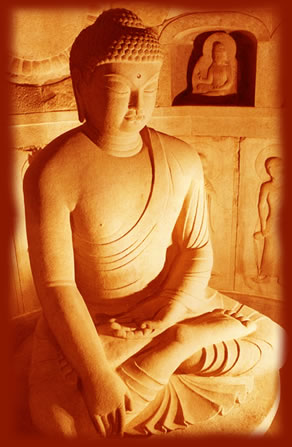Buddha was born in B.C. 563 and died at the age of eighty in B.C. 483.

Unlike the preceding years, the last few weeks of the Buddha's life are recorded in great detail in the Mahaparinibbana Sutta (Discourse Concerning the Entry into Final Nirvana). Mara the Evil One confronted the Buddha during his last days, as, according to the tradition, he had done often during the Buddha's life. Nevertheless, the Buddha had always defeated Mara and grew spiritually each time. On this occasion he again urged the Buddha to retire from the earthly scene and enter final nirvana, and receive his just reward. But this time Mara received what might be favorable response. Buddha assured Mara that he would die and enter nirvana in three months. The narrative makes it clear however that there was no comfort to be derived from this fact by Mara, since the Order of Buddhist Brethren and the Order of the Sisters, and lay disciples of both sexes, were now thoroughly established. They had become true hearers, wise and well-trained, ready and learned, . . . able to tell others of the doctrine, preach it, make it known, establish it . . . and make it clear.' There was in existence a Buddhist missionary task force ready and able to witness to the Dhamma and instruct converts in the Buddhist way. The Evil One could find little comfort in the Buddha's death, because his enemy had grown in size and stature. Seven days after the Buddha's death at Kushinagara, a small town (modern Kasia) to the northwest of Patna and just to the south of the border of Nepal, they cremated his body. The occasion was marked by ceremonies of the kind which in those days were observed at the death of a king. Each of the eight clan-groups received items of the Buddha, and after the cremation they built a sacred cairn over their portion of the artifacts, a form of memorial known in India as a stupa. The stupa became the object of the Buddhist devotions, and eventually, developed into the form known in South-East Asia as a "pagoda."
Buddha died of an illness brought on by some error in diet. He became ill through eating Sukara-maddavam, prepared for him by a lady adherent named Cundo. The word means 'hog's flesh' or possibly something which wild boars are fond of that has something of the nature of a truffle. Some say that it is not boar's flesh but Sukarakanda or hog's root, a bulbous root found chiefly in the jungle and which Hindus eat with great joy. It is a Phalahar that is eaten on days of fasting.
Buddha said to Ananda, "Go Ananda, prepare for me, between twin Sal trees, a couch with the head northward. I am exhausted and would like to lie down". A wonderful scene followed. The twin Sal trees burst into full bloom although it was not the blossoming season. Those flowers fell on the body of Buddha out of reverence. Divine coral tree flowers and divine sandalwood powders fell from above on Buddha's body out of reverence.
Lord Buddha said, "Come now, dear monks. I bid you farewell. Compounds are subject to dissolution. Prosper ye through diligence and work out your salvation". |